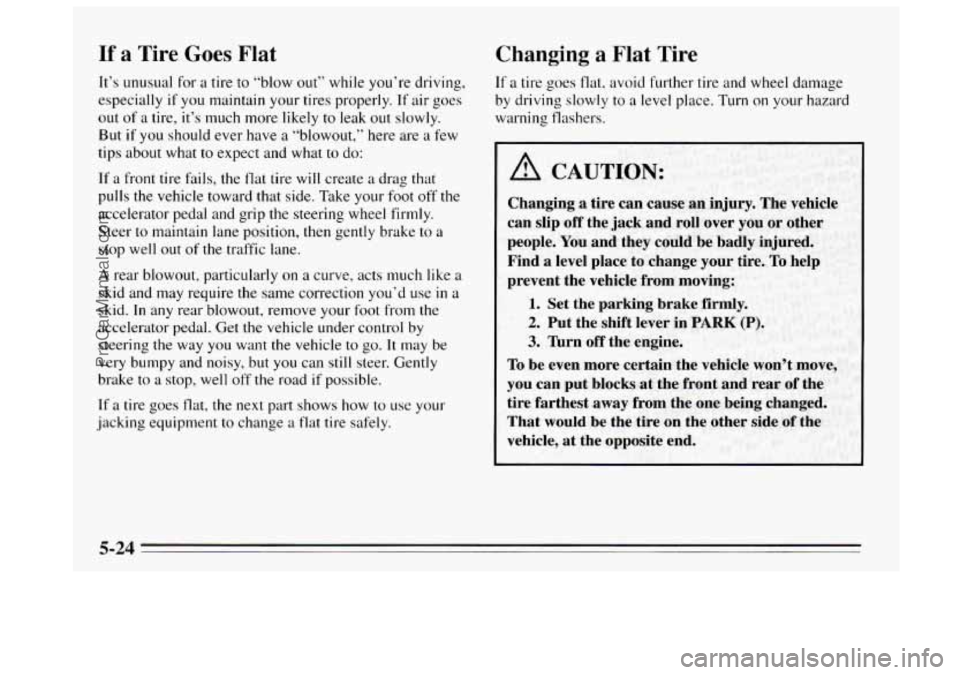Page 181 of 340
Towing Your Vehicle
Try to have a GM dealer or a professional towing
service tow your Buick. The usual towing equipment is:
A. Sling-type Tow Truck
B. Wheel-lift Tow Truck
C. Car Carrier
If your vehicle has been changed or modified since it
was factory-new by adding aftermarket items like fog
lamps, aero skirting, or special tires and wheels, these
instructions and illustrations may not be correct.
Before you do anything, turn
on the hazard warning
flashers.
When you call, tell the towing service:
0
0
0
0
0
That your vehicle cannot be towed from the front or
rear with sling-type equipment.
That your vehicle has front-wheel drive.
The make, model, and year
of your vehicle.
Whether you can still move the shift lever.
If there was an accident, what was damaged.
When the towing service arrives, let the tow operator
know that this manual contains detailed towing instructions and illustrations. The operator may want
to see them.
5-7
ProCarManuals.com
Page 183 of 340
When your vehicle is being towed, have the ignition key
off. The steering wheel should be clamped in a
straight-ahead position, with
a clamping device
designed for towing service.
Do not use the vehicle’s
steering column lock for this. The transaxle should be
in
NEUTRAL (N) and the parking brake released.
Don’t have your vehicle towed on the front wheels,
unless
you must. If the vehicle must be towed on the
front wheels, don’t go more than
35 mph (56 km/h) or
farther than
50 miles (80 km) or your transaxle will be
damaged.
If these limits must be exceeded, then the
front wheels have to be supported
on a dolly.
A CAUTION:
5-9
ProCarManuals.com
Page 184 of 340
r ront Towing Hookups
Attach T-hook chains in
front of the wheels into the
side slots
of the cradle on
both sides.
I
Use wheel lift or car carrier equipment. Additional
ramping may be required for car carrier equipment. Use
safety chains and wheel straps.
ProCarManuals.com
Page 185 of 340
NOTICE:
Do not tow with sling-type equipment or
fascia/grille damage will occur.
Towing a vehicle over rough surfaces could
damage a vehicle. Damage can occur from vehicle
to ground
or vehicle to wheel-lift equipment. To
help avoid damage, install a towing dolly and
raise th.e vehicle until adequate clearance
is
obtained between the ground and/or wheel-lift
equipment.
Do not attach winch cables or J-hooks to
suspension components when using car carrier
equipment. Always use
T-hooks inserted in
T-hooks slots. Attach
a separate
safety
chain around the outboard
end
of each lower control
arm.
ProCarManuals.com
Page 186 of 340
Rear Towing Hookups
Att.ach 'T-hook chains into
slots in the bottom of the
floor pan just ahead of the
rear wheels
on both sides.
Use wheel
lift or car carrier equipment. Additional
ramping
may be required for car carrier equipment. Use
safety chains and wheel straps.
ProCarManuals.com
Page 187 of 340
NOTICE:
Do not tow with sling-type equipment or the
rear bumper valance will be damaged.
Towing
a vehicle over rough surfaces could
damage a vehicle. Damage can occur from vehicle
to ground or vehicle to wheel-lift equipment.
To
help avoid damage, install a towing dolly and
raise the vehicle until adequate clearance is
obtained between the ground and/or wheel-lift
equipment.
Do not attach winch cables or J-hooks to
suspension components when using car carrier equipment.
Always use T-hooks inserted in
T-hooks slots. Attach
a separate
safety
chain around the outboard
end of each lower control
arm.
ProCarManuals.com
Page 198 of 340

If a Tire Goes Flat
It’s unusual for a tire to “blow out” while you’re driving,
especially if you maintain your tires properly. If air goes
out
of a tire, it’s much more likely to leak out slowly.
But
if you should ever have a “blowout,” here are a few
tips about what
to expect and what to do:
If a front tire fails, the flat tire will create a drag that
pulls the vehicle toward that side. Take your foot off the
accelerator pedal and grip
the steering wheel firmly.
Steer to maintain lane position, then gently brake
to a
stop well
out of the traffic lane.
A rear blowout, particularly on a curve, acts much like a
skid and may require the same correction you’d use
in a
skid. In any rear blowout, remove your foot from the
accelerator pedal. Get
the vehicle under control by
steering the way
you want the vehicle to go. It may be
very bumpy and noisy, but
you can still steer. Gently
brake
to a stop, well off the road if possible.
If a tire goes flat, the next part shows how to use your
jacking equipment to change
a flat tire safely.
5-24
ProCarManuals.com
Page 200 of 340
Turn the nut holding the jack and wrench
counterclockwise and remove it. Then remove the jack
and wrench.
If there is a wheel cover, loosen the plastic nut caps with
the wheel wrench. They won’t come off. Then, using the
flat end
of the wheel wrench, pry along the edge of the
wheel cover until it comes
off. Be careful; the edge may
be sharp. Don’t
try to remove the cover with your bare
hands.
To remove a center cap, use
the wrench to pry gently at
the notch. Don’t use a tool
that is narrower than the
wrench to pry at this notch.
If your vehicle has wheel
nut caps, remove them
using the wheel wrench.
5-26
ProCarManuals.com